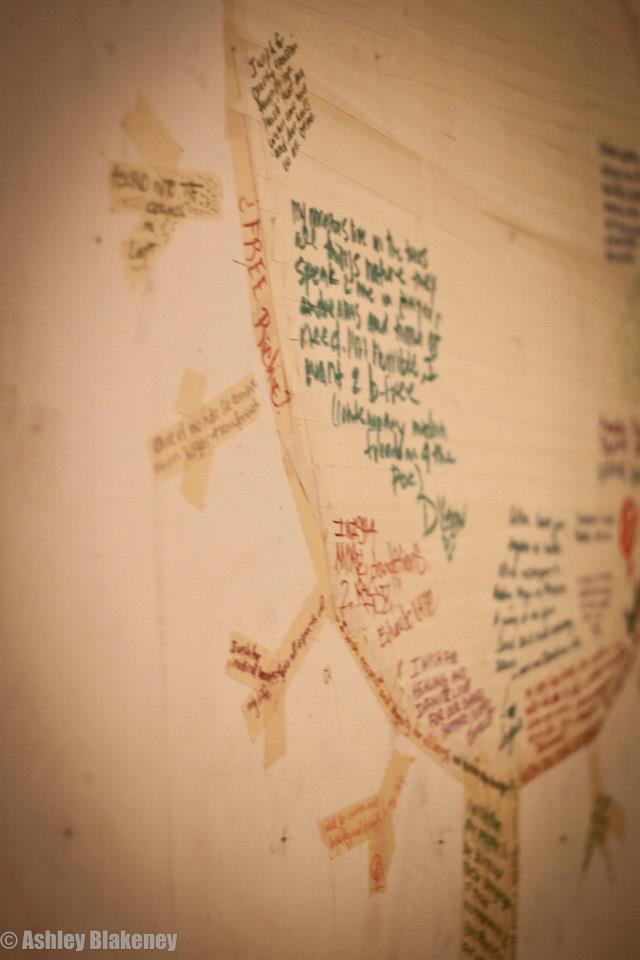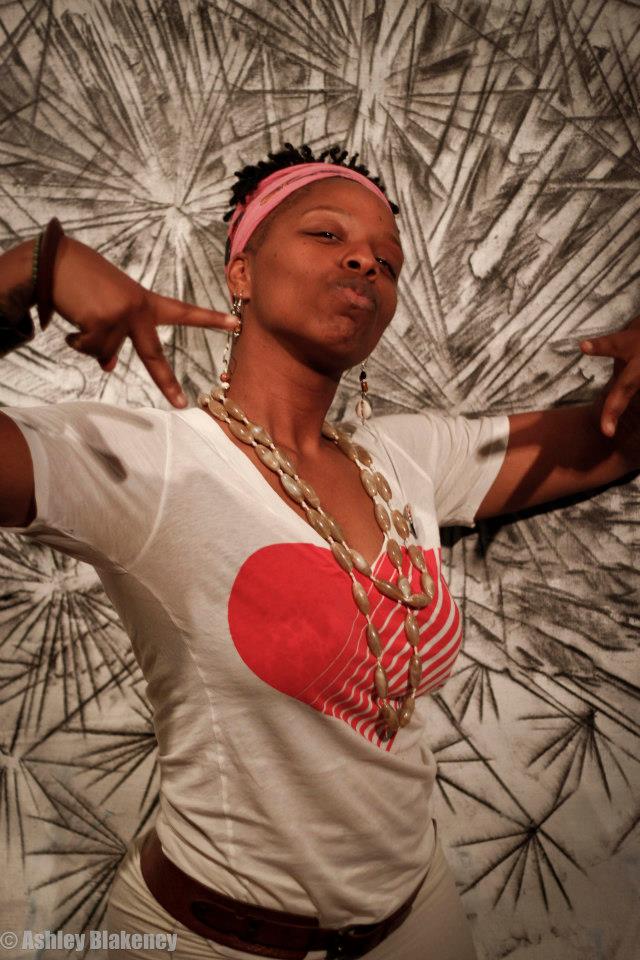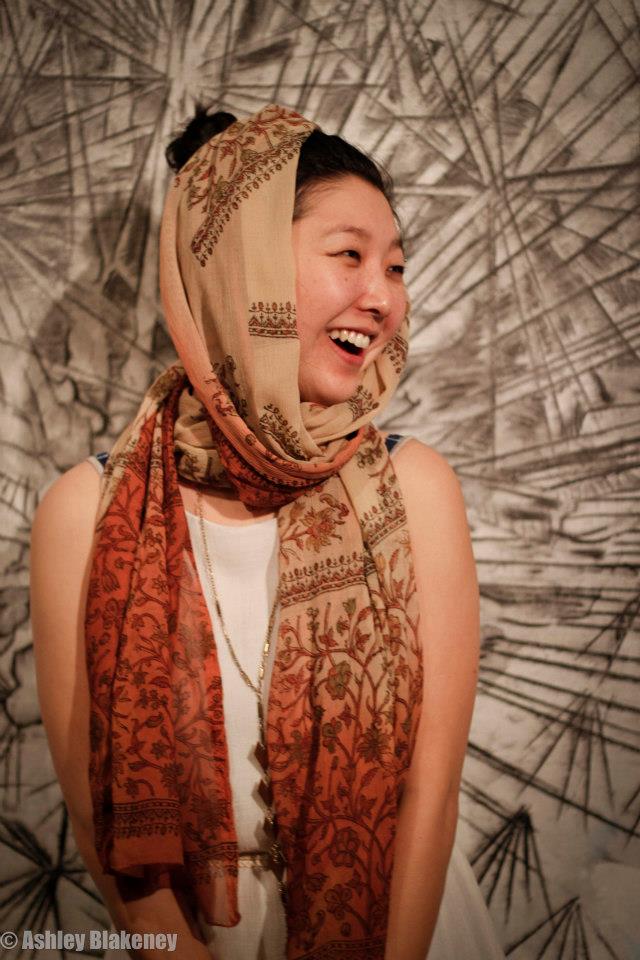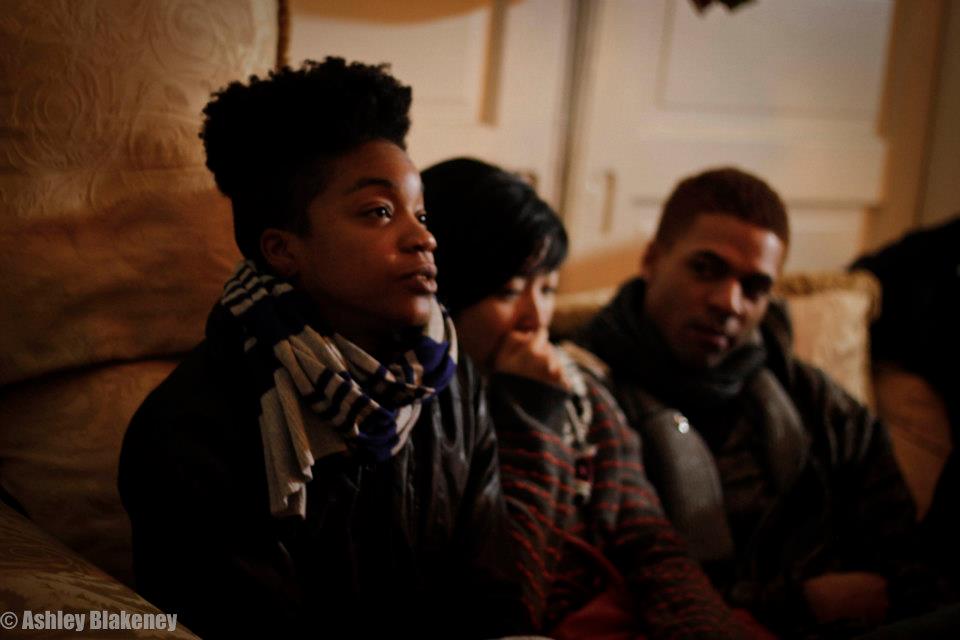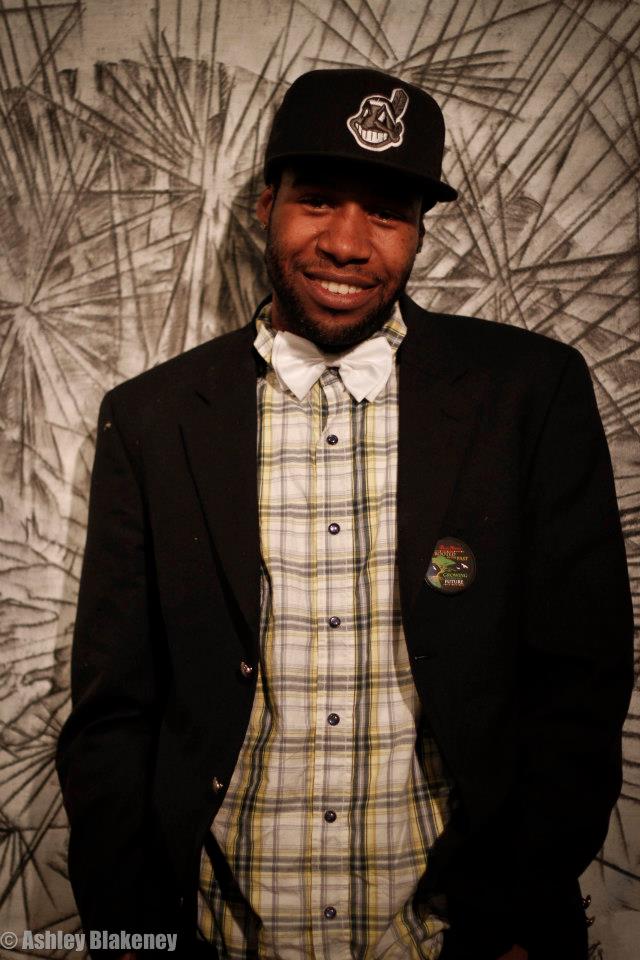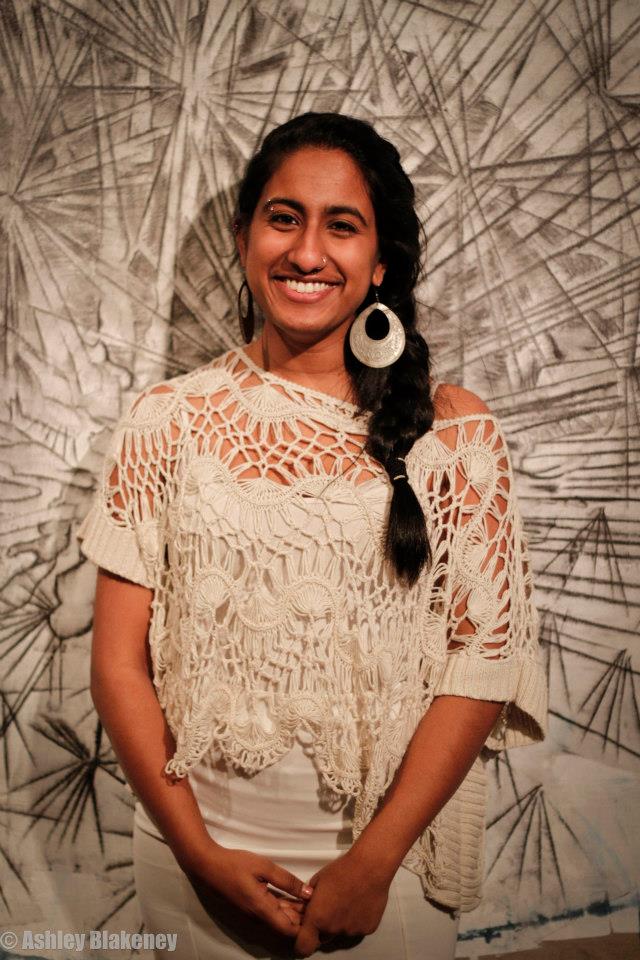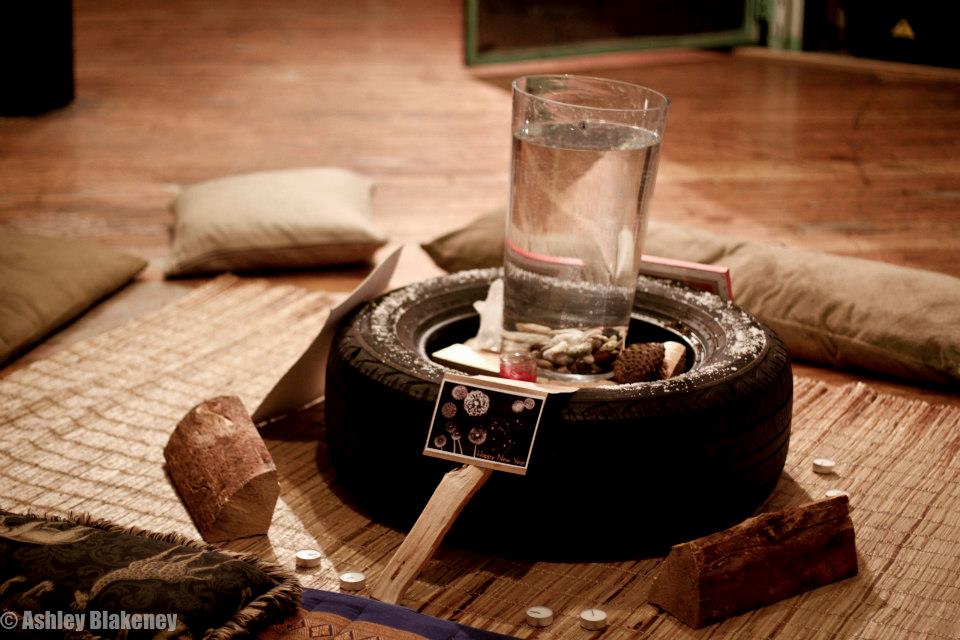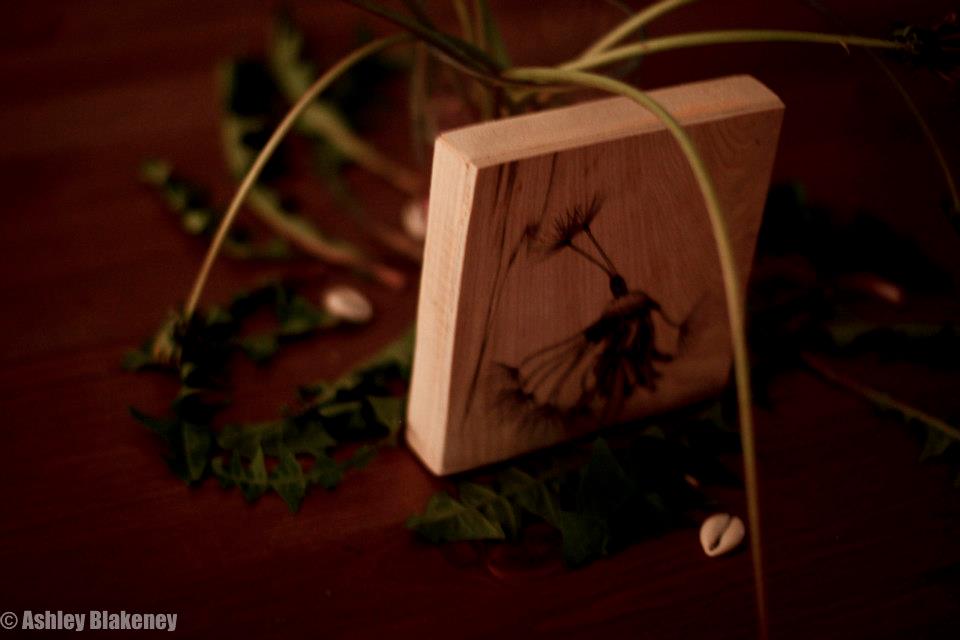By Matthew Morowitz
“Dandelion Wishes.” Photo courtesy of Ashley Blakeney.
As mentioned in the previous feature on Patrisse Cullors, March 9, 2013 saw the premier of “Freedom Harvest Presents: #RISEOFTHEDANDELIONS,” a performance/installation created in response to the excessive force and brutality by the Los Angeles County Sheriff’s Department (LASD). Presented at the Pieter Performance Space in L.A and in conjunction with Patrisse’s Coalition to End Sheriff Violence in Los Angeles Jails, the event was conceived and spearheaded by an arts-focused offshoot of the Coalition, the Freedom Harvest Collective.
The Collective, which consists of Patrisse Cullors, Jasmine Wade, Shruti Purkayastha, Jermond Davis, and Gonji Lee, organized this event as a way to bring together Black, Latino, and allied voices to show their resilience in the face of a prison industrial complex that incarcerates members of these communities at a larger rate than any other group of people in the U.S. In L.A. County in particular, violence and human rights violations by law enforcement officials outside and within the prison has been an issue faced by these marginalized communities for decades and, while there has been much discussion focused on the problems, not a lot had been devoted to the possibility of hope. “#RISEOFTHEDANDELIONS” was created to address this need for hope, showcasing a variety of works- audio, visual, performance- that centered around the symbol of the dandelion and focused on communities coming together to reclaim their dignity and freedom in the face of this state sponsored institution of oppression.
“Patrisse.” Photo courtesy of Ashley Blakeney.
Art in Odd Places (AiOP) was able to talk to/get testimony from Patrisse, Shruti, Jasmine, Gonji, and Jermond on the formation of the Collective and their experiences of and reactions to the March 9th event. This piece is the first in a series that will focus on the Collective, the event, and the artists and individuals involved.
“Art that would free the (black) kidnapped imagination, so often held hostage by trauma, everyday survival and constant state violence.” -Jasmine Wade
For Patrisse, utilizing art to help relay a message, especially connected to the issue of jail violence, was not a new situation for her. Through almost the entirety of 2012 her piece, “Stained: An Intimate Portrayal of State Violence,” toured around L.A. County. While “Stained” was one of the impetuses that helped birth the Coalition, it became clear that more needed to be done to address the feelings of hopelessness that surrounds the issue, as Patrisse saw that both the people who went through the system and their loved ones needed a rallying point to help them move past the traumas they’ve experienced.
The Freedom Harvest Collective was created as a way to help start these dialogues on resilience and reclamation. When bringing together crewmembers for this new initiative, Patrisse sought out local artists who she new also had community organizing experience within L.A. County. As for the artists that Patrisse sought out, they had their own reasons for wanting to become a part of this newly formed collective.
For Gonji, joining the Collective was a way to “[not] only to see how our politics might inform our art, but to practice our craft in a way that also informs the work we do.” After working in community organizing for what she refers to as the “nonprofit industrial complex,” Gonji was looking for a way to integrate more art into movement work, as she believes art has a nurturing power that both helps people better understand the issues at hand, as well as heal from them on an emotional/spiritual level:
“I believe that creativity contains a vital force that keeps our spirits alight when we feel weary, and takes us into flight in moments of celebration. It’s proven to be an invaluable tool in Movement work, a revolutionary tactic that creates cataclysmic shifts in people’s ideologies and material conditions, while healing our souls in a viral fashion. I joined the Freedom Harvest Project to nurture our art in order to address the conditions inside a terrorist nation that locks up 2.7 million of its own people in iron cages, maintaining new slave order that threatens Black and Brown people, as well as families and friends who continue to stand in brave defiance.”
“Gonji.” Photo courtesy of Ashley Blakeney.
Jasmine saw her participation in the Collective as a way to “to practice and create art of disruption.” Having first been a part of Patrisse’s piece “Stained,” Jasmine gained firsthand experience in how art could be a transformative experience, showing how it can be used to draw light on experiences and realities that have been often disregarded and normalized in the mainstream American imagination:
“I have been involved in community based organizations and organizing for the last 6 years addressing many of the struggles communities of color and black communities face. For the past year or so I’d been studying black artists/organizers like Amiri Baraka- learning how they engaged the larger black community in the struggle against racism, poverty, capitalism, state violence- towards Black liberation. Coming together with Freedom Harvest, it was important and affirming for me that as a group we hold the black experience that is often disregarded and normalized. I wanted to practice art of disruption; I wanted to create collectively towards healing and freeing our people’s imagination-therefore spirit!”
When she was approached to be a part of this newly formed collective, Jasmine signed on without any hesitation:
“I was excited to get involved and manifest Freedom Harvest Collective because I love everyone on the team, their vision, their tenacity at fighting for the real freedom of all of our peoples, and that we are driven by spirit. We are a collective whose ancestors circle the globe and still we found one another presently, coming together to make art that speaks truth to power and power to imagination. Freedom Harvest Collective, to me, is taking care of our ancestors’ gardens that began this journey towards freedom, doing the work and cultivating resilience, struggle and love of oneself and another; Freedom Harvest continues this work and love of our elders, understanding our struggles today are not new but rather refined, transformed, we continue this legacy of freedom fighters, freedom lovers, freedom artists. The Freedom Harvest Collective shares a deep love of our peoples and commitment to building our alternative vision; #RISEOFTHEDANDELIONS was our first portal-installation to the community.”
“Jasmine.” Photo courtesy of Ashley Blakeney.
Jermond’s reasons for getting involved with the Collective and the event #RISEOFTHEDANDELIONS were simple, he felt he just immediately connected with the name and message of the movement that was coming together:
“My involvement with the Freedom Harvest was adding to the creative thought, as well as partnering with Rey by sharing through music. The reason why I chose to get involved-the title of the name-is self-explanatory (Freedom Harvest).”
“Jermond.” Photo courtesy of Ashley Blakeney.
Finally, Shruti, a firm activist for transgender rights, especially focusing on the effects the prison industrial complex has on the trans community, and an API ally saw her involvement coming out of witnessing “Stained,” understanding for the first time all of the different physical and emotional impacts the prison system has on everyone involved with it:
“I remember just really all the levels of impact that it had on me, because I had been doing, just studying, reading, and talking to people about, people who had been inside the system and jail, and the folks who had been impacted and affected by the system in different ways. I’ve been doing this work for about five year now, but I think it was the first time that I had really understood all the impacts on a body level and an emotional level, and that was shared by a whole community, how deep that impact is because ‘Stained’ was definitely a multilayered piece.”
After joining Patrisse and the others on a tour of the men’s central jail facility in downtown L.A., the shock of hearing the institution praise itself while witnessing the claustrophobia of the space itself firmly set into Shruti’s mind a desire to confront this oppression in a way that not only brings light to the issues surrounding it, but inspire hope and resilience in the communities that have been affected by it:
“We did a tour of the men’s central jail facility in downtown LA, and just having “Stained” as my framework for what was happening and entering the space solidified that. Even though there were the system people, the jail captain and all of those folks were trying to impress us with their different programs; there was still just this, almost like a quality of air where you just felt people trapped…. we started meeting about really framing our Freedom Harvest arts collective within the framework of resilience, telling stories of resilience and really framing our work within this oppressive system… I think for all of us it was really important having that resilient framework as contextualizing the politics; on one level, just on a personal level to keep us going, talking about resilience is something that doesn’t always get spoken about within the prison industrial complex because there is just so much oppression and sadness and trauma around it that this was sort of a different way of talking about it, a different way of telling that story.”
“Shruti.” Photo courtesy of Ashley Blakeney.
“The night was illuminating and sad, uplifting and profound. It was a freedom portal.” –Gonji Lee
As the Collective came together, they decided on the dandelion as their rallying symbol for this movement of hope and resilience they wanted to set forth. With that agreed upon, the next step was how to actually go about getting these ideas out there. Unlike her first work, “Stained,” for this new project Patrisse was interested in setting up an installation space where works and performances related to these ideas of healing and reclamation could be presented to the public by the members of the Collective, as well as by artists and performers that they knew were interested in making impactful works around these topics.
“Leading up to the event, there were a lot of different pieces we were pulling together and a lot of us hadn’t really done an installation show before, so it was new for a lot of us.” Shruti recalled after it was determined that the next piece was going to be an installation. “My background is in theater so I was used to thinking about set design and lighting and that kind of stuff; it’s a little different thinking of it in terms of an installation. Up until the date itself we were definitely running around and pulling a lot of pieces together, we definitely supported our core group here and supported each other a lot and we had regular check ins and work dates. I transformed my garage into a workspace.”
The date, March 9th 2013, saw the premiere of “Freedom Harvest Presents: #RISEOFTHEDANDELIONS” at the Pierter Performance Space in L.A. Overall, Patrisse was very proud of everything that had happened, feeling that it definitely helped brought about the kinds of actions and dialogues she wanted to see help move the movement forward:
“It probably was one of the most powerful events that I’ve ever participated in and was able to bear witness to, mostly because it was very personal to me. The event was very much about ‘how do we understand and reframe folks who’ve been incarcerated and the family members that they are connected to?’ I think that the experience felt like we were definitely participating in something bigger than ourselves, and I think that as someone who helped curate the event and also be an artist for the event I felt like we were making art that was touching and impacting people and it had the capacity to really build a new movement of looking at the ways in which we can transform this nation’s relationship to folks who have been incarcerated, and also really look at what would be viable solutions, what are alternatives to incarceration.”
On the night of the performance, the area around the space was actually being used for filming a movie and there were a lot of police sirens and car chases going on around them, something many of the members of the Collective found to be very apropos, as the simulated police violence outside only served to reinforce the desire for calmness and healing within the performance space.
“Ironically the same night of the event, they were shooting a scene for an upcoming movie that involved high speed police chases, loud helicopters flying low, sirens and tire screeches- a typical night in the hoods of Los Angeles, only this night it was a movie shooting,” Jasmine describes. “The noise and racing police cars happening outside was intense, but inside the event that chaos dissipated.”
“Central Space.” Photo courtesy of Ashley Blakeney.
The space itself, described by everyone as a freedom portal, was set up to create a sense of intimacy and comfort for those who would be in attendance, as the members of the collective did not want this event to feel like a performance or a concert. As Jasmine describes:
“Everyone was seated closely to one another on the floor, in the comfort of pillows, carpets, and one another’s presence as they sipped on dandelion root tea. We wanted this event to be ceremony; it was reminiscent of back woods ceremonies held by ancestors, or stolen moments and circles that our ancestors and elders had to brave in the face of extreme repression and violence. These stolen moments and ceremonies was how our elders stayed resilient and rooted in their dignity and power.”
Gonji’s description of the space further shows how the site was not only a point of comfort but also a place for rallying together:
“We had Malcolm [X]’s cutout peering in from the window, making his presence as a guardian all the more real. Countless art pieces of dandelions hung from the sky while Black, Brown and allied peoples spat our words of rage, resilience and freedom. People shared many vulnerable stories that felt raw to the touch, and though the night had difficult elements to it, I could feel all of our souls being renewed to continue the fight. As an ally to the cause, I had open ears and an open heart during the event, allowing my body to soak up everything that everyone present in the space brought in contribution to space.”
Reclamation of the past and focus on Ancestors was a major part of the event and the works behind it. As the issues surrounding incarceration affected families as much as it did individuals who were in the prisons, it was also important to take a look at how issues related to incarceration-slavery, colonialism, racism-had affected Black, Latino, and allied communities since the founding of the U.S. Shruti found it was important for the event to draw from this reverent and spiritual past, as it was the best way to reclaim these communal spaces where ancestor groups had once gathered to learn and heal:
“The whole time for me, a lot of making art like this, making theater like this, is reclaiming these sort of spiritual and ritual centers that our people have lost through colonization, through all these forms of state oppression. We’re thinking about indigenous theater, theater before colonization. Theater and art was sort of the center where people learned how to interact with each other, learned morality, it really created the moral structure for society. What colonization did was take that space, which was the alter-community space, and put it on a stage or put it in a building or basically remove it from the people. In terms of what we were trying to create with this piece in particular and I think really the rise of the dandelions event overall was to reclaim that ritual space where people are able to come together and share stories and heal around trauma and share with each other, really learn from each other to build something that is better for each other, for our communities.”
“Dining Table.” Photo courtesy of Ashley Blakeney.
Finally, Jermond’s description sums up the impact the space itself had on shaping the atmosphere of the entire event:
“The event was a very emotional machine that shed light on every aspect of what freedom looked like from each artist’s perspective, which was fabulous! The atmosphere was a collective of many walks of life, many ethnic groups that I felt was powerful and really harmonious and a sacred space to feel and share emotions.”
Although the Collective has been formed and the space set, this is unfortunately the end of part one of this series. Stay tuned for part two where we will discuss some of the works created for the event and hear about some of the moments the Collective found to be the most memorable.

